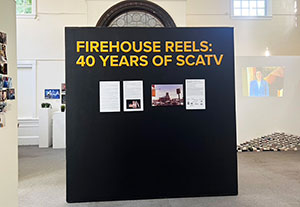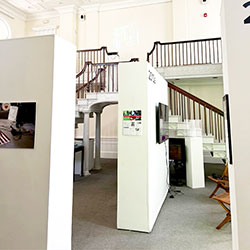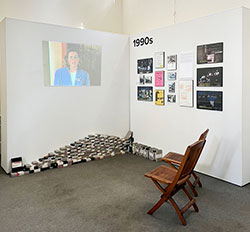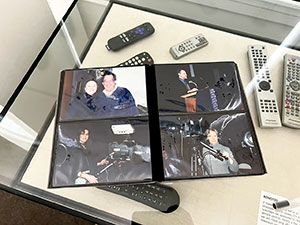
A history of SCATV, “Firehouse Reels,” is currently on display at the Somerville Museum through July 9.
By Raga Chilakamarri
Housed in the Somerville Museum, a quaint red brick building at the corner of Westwood Road, a one-room exhibit opened below the arch of a grand staircase. A projector pointed above the staircase landing flickered through old countdown video animations from the Somerville Community Media Center Archive, the title “SCAT” flashing on, displayed in different designs.
Somerville Community Access Television (SCATV) is the oldest public access station in Massachusetts, and the Firehouse Reels exhibit, which opened on June 3, tracks through its forty years history.
The exhibit’s name alludes to how SCATV operates out of a rehabilitated firehouse in Union Square, which has since evolved into the Somerville Media Center, a digital makerspace and education hub for local radio enthusiasts and podcasters.
 SCATV’s origins began with controversy. In the 1970s, the Warner-Amex cable company agreed to supply the necessary space and equipment for local producers to develop their own programs, one of which was Dead Air Live, the longest running live public access television show in the world.
SCATV’s origins began with controversy. In the 1970s, the Warner-Amex cable company agreed to supply the necessary space and equipment for local producers to develop their own programs, one of which was Dead Air Live, the longest running live public access television show in the world.
However, tense relations and a desire for more autonomy pushed Somerville producers to diverge from Warner Amex, negotiate a new television contract, and establish a non-profit funded by a percentage of the cable company’s earnings in the community. Thus, SCATV was born, made to be operated for and by Somerville’s own.
In a recent episode of Dead Air Live that featured a panel of key pioneers of SCATV, Linda Horton, who was the Director of Mayor Brune’s Cable and Television Advisory Board, reflected on the importance of public access in a pre-internet world. “There was no other way for people to express their views. There was no other way for people to put a mirror up to our own local life and see it for what it was rather than seeing it filtered through the mass media. So, this was like a very exciting, energizing experience at the time where there were really no other alternatives for people like us to be able to talk about what we felt was important in ways that we felt they needed to be discussed,” Horton said.
Organized by decade beginning with the 1980s, each section of the exhibit features a collection of media from that era, including video recordings, newspaper clippings, posters, equipment, and photographs. The changes in technology are evident: the 80s showcases three-quarter inch tapes while the 2010s corner displays bright, portable standing lights and a greenscreen.
On the 1990s panel, a projector plays a compilation of video clips, demonstrating a wide variety of programming. Examples include the Youth Video Prevention Project PSA (1995) speaking about peer-pressure and drug use; footage from the Somerville Boxing Club; and a crayon-like animation of a house, narrated by a young child. Below, stacks of VCR tapes decorate the floor. Old fliers advertise for initiatives engaging with pockets of communities within the city, like The Mirror Project which intended to educate teenagers on utilizing video production for self-discovery.
Throughout the past four decades, SCATV hasn’t shied away from controversy and Firehouse Reels relates how SCATV seems to proudly embrace it, serving as a bastion of free speech. In fact, one wall is simply and boldly labeled “Controversy.” The description begins with, “How do you like your controversy? Political? Gay? Nearly naked and covered in soup?” before discussing a myriad of boundary-pushing content published through SCATV. Markedly, the programming throughout the decades featured a diverse representation of people, including content produced by teenagers and immigrant communities, while also welcoming shows in different languages.
Walking through the Firehouse Reels exhibit, sitting to take in the video archives, and perusing through old photos will likely take visitors less than an hour, but it is a worthwhile trip. SCATV played an influential role in Somerville as a platform for residents to educate, to create, and to share meaningful stories, a powerful avenue for neighbors to connect with one another. From that initial rally to establish SCATV in the 80s, to championing innovative content in the 2000s, to even adapting to a pandemic in our contemporary moment, SCATV’s spirit of community, access, and television reigns on.
Firehouse Reels runs through July 9 at the Somerville Museum, 1 Westwood Rd. $5 admission. Exhibit hours are Thursdays from 2:00 to 7:00 p.m., Fridays from 2:00 to 5:00 p.m., and Saturdays from 12:00 to 5:00 p.m.













Reader Comments